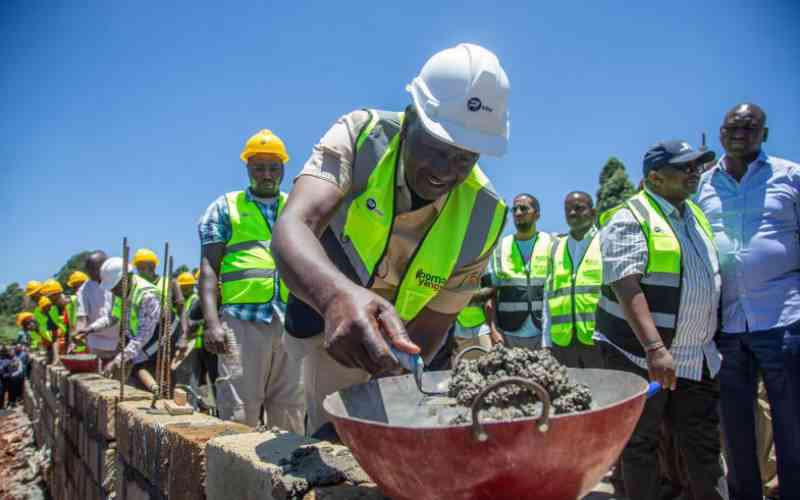
Celery is a biennial plant that is farmed as an annual plant.
Grown for its stalks, leaves and seeds, its demand is increasing as people become more health-conscious.
Alfred Kamau, a celery farmer in Kiambu, says the crop likes moderate conditions – not too hot nor too cold. It hates frost and extreme heat. The crop will thrive in full sun or part shade.
Kamau shares insights on its production:
Land preparation
Choose a protected spot, without strong winds. Celery is a shallow-rooted plant with a high demand for water and nutrients. It grows best in moist but well-drained soil that is organically rich.
Spread a handful of balanced organic fertiliser evenly per square and work it in.
“Mound the soil to further improve drainage, then leave it for a week before planting the seedlings,” says Kamau.
In Kenya, the most common varieties are Pascal and Tall Utah, which are both used for stalks. The seeds are found at many agrovet outlets.
Fertiliser requirements
Celery does well in slightly acidic soil (6.0 to 6.8pH). It is very important to carry out a soil test to know which nutrients are lacking.
The plant has a high nitrogen requirement. The first application should be done at the time of planting to boost root formation. About a month after transplanting, top dress with nitrogen fertiliser then do it again in the third month.
Propagation and planting
When preparing a nursery seedbed, mix the soil with compost manure rich in nitrogen.
“Then raise beds of 8 by 1.25 metres with a good width that is easy to work with. Target to work with 450 grammes of seeds per hectare. You should then sow the seeds and lightly cover them,” says Kamau.
The seeds will start germinating after four to eight weeks. One can soak the seeds in the water a day before sowing to hasten germination. Celery seeds can also be directly sown into the field as long as there is a good irrigation system to ensure that it does not go without water.
“If you choose to use the seedbed method, your seedlings will be ready for transplanting about two months after sowing. “Plant your seedling with a spacing of 60cm by 15cm or 45cm by 15cm. Do not plant the seedlings too deep. Keep the roots of the plant to a depth of not more than 2cm,” says Kamau.
Blanching Celery
This is the process where sunlight is blocked off from the developing petioles, thereby inhibiting chlorophyll formation in the stalk. The pale celery stalks tend to be more tender and have a better taste than the green petioles which have a bitter taste. This blanching is not to be confused with the cooking one.
It is done once the plant gets to about 25cm. The crops are covered using boards, mulch, or soil moulds and left to mature without the greening of the stalk.
This process is only done to the stalk to improve its taste especially if you intend to eat it raw.
Pests and disease
Tarnished Plant Bug: To control it, spray appropriate pesticides and clear weeds adjacent to the crop.
Aster (six-spotted) Leafhopper: Apply pesticides in a 10-day interval.
Aphids: Apply recommended pesticides or inter crop with marigold, which is known to be a pest retardant.
Diseases include damping-off, leaf blight, fusarium yellows and pink rot.
Harvesting
Celery can be harvested four to five months after sowing. Younger celery can be harvested if the price is high in the market.
If you intend to harvest the seeds, wait until they turn light brown. You should harvest them immediately to avoid loss. To harvest, cut the stalks just above the ground with a sharp blade. You should trim the outer leaves off and pack in wooden or plastic crates. Use machine harvesting in large scale production.
Market
The celery market is growing given that people are more informed and are mindful of their diet. Fresh celery costs Sh150 per kg in wholesale markets and about Sh200 per kg in the retail market.
 The Standard Group Plc is a multi-media organization with investments in media
platforms spanning newspaper print operations, television, radio broadcasting,
digital and online services. The Standard Group is recognized as a leading
multi-media house in Kenya with a key influence in matters of national and
international interest.
The Standard Group Plc is a multi-media organization with investments in media
platforms spanning newspaper print operations, television, radio broadcasting,
digital and online services. The Standard Group is recognized as a leading
multi-media house in Kenya with a key influence in matters of national and
international interest.
 The Standard Group Plc is a multi-media organization with investments in media
platforms spanning newspaper print operations, television, radio broadcasting,
digital and online services. The Standard Group is recognized as a leading
multi-media house in Kenya with a key influence in matters of national and
international interest.
The Standard Group Plc is a multi-media organization with investments in media
platforms spanning newspaper print operations, television, radio broadcasting,
digital and online services. The Standard Group is recognized as a leading
multi-media house in Kenya with a key influence in matters of national and
international interest.










